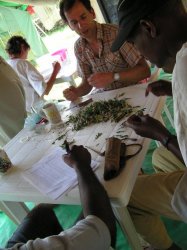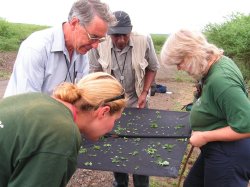| |
Moths and Butterflies (a.k.a., Lepidoptera)
Lead researcher: David
Assistant researcher: Joseph
Volunteer teams:
- Bernise and Elfree - November 4 - 7
- Chris and Kumar - November 9 - 12
- Julia, Kate and Lanette - November 14 - 17
 Beating the Acacia Trees:
Beating the Acacia Trees:
We volunteers assisted David and Joseph to collect moth larvae and butterfly caterpillars. Two methods were used. One, manual picking and the other beating. Now I didn’t read anything about beating Acacia trees in my Briefing packet. But after being scraped, scratched, pricked and impaled on the thorns of these trees, the beating part seemed to make a lot of sense and provided a cruel sense of satisfaction. Indeed, after having stepped on a thorn during the trip prior to this module, it felt like some justice was served. Julia perhaps may have felt the reverse since her foot was stuck with a thorn after she beat the trees.
 |
We manually picked and beat 3 species of Acacia during this project: A. melliflora, A. senegal and A. raficerens. During the manual phase, we looked for and collected anything indicative of Lepidoptera such as leaf mines, galls, casings, chrysalis, and of course worms. There were worms feeding or crawling about and “spinners,” which were those that were found between folded leaves spinning their silk in preparation for their pupae phase. I was not very successful at finding much, despite having spent years in my youth helping my father look for hornworms on our tomato plants.
|
| The beating produced much better results. Holding a contraption over which a cloth was stretched in one hand, we used a stick to beat the trees with the other. Leaves, small branches, spiders, ants, and worms fell onto the cloth. Scanning for and picking out the worms, we placed them in marked containers for future categorization and processing.
|

|
One interesting myth was shared with us. David said that many people believed and still believe that Acacia trees and ants had a symbiotic relationship. If insects attacked the tree, the ants would kill the insects. The tree, in turn, would provide shelter and nourishment in the galls, hollow thorns or other structures. In fact, it seems that there is a relationship with the ants their larvae and the Lepidoptera spinners. The ants will milk the worms to feed their own larvae. I don’t know if the relationship is parasitic or symbiotic. It could be that the ants do provide some protection to the worms, since it is an important food source.
David mentioned that we found 2 or 3 new moth species during this Earthwatch expedition. Exciting news on the entomology front! I’m looking forward to learning what they will be named and what his findings were for this project.
| |













 Beating the Acacia Trees:
Beating the Acacia Trees:

